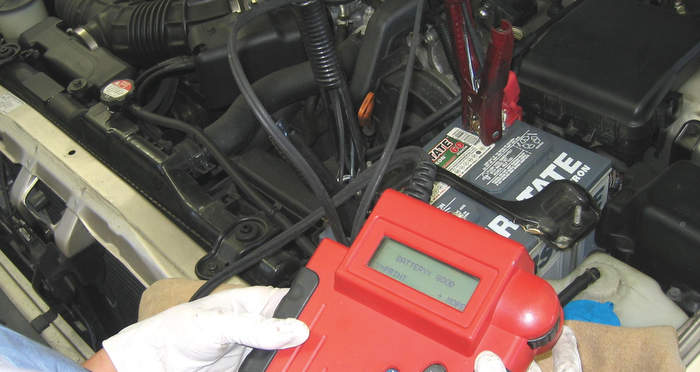The ASE G1 test contains 55 scored, job-related questions, 15% of which will concern electrical maintenance and repairs. From the ASE G1 study guide, you will need to know how to:
• Perform battery tests (load and capacitance); determine needed service.
• Check voltages, grounds and voltage drops in electrical circuits; interpret readings.
Understand Hot and Cold Amps
Battery maintenance and service starts with an understanding of cranking amps and reserve capacity. Cranking amps are rated in two ways: cranking amps (CA) and cold cranking amps (CCA). The best sources for these specifications are the owner’s manual or battery catalog.
CA
The CA rating of a battery is the maximum amount of amps a battery is capable of producing at an ambient temperature of 32º F for 30 seconds while maintaining at least 1.2 volts per battery cell. The battery must crank or rotate the crankshaft while at the same time maintain sufficient voltage to activate the ignition system until the engine fires and maintains rotation.
 CCA
CCA
CCA is the more relevant of the two measurements for lead-acid batteries because CCA is measured at 0º F. For example, a battery with a 700 CCA rating means that battery sustained a 30-second load test, while fully charged, at 0º F, while maintaining 7.2V or more.
The higher the CCA rating of a battery, the more starting power that battery can deliver in colder climate. CCA ratings can range from 400 all the way up to 1,500 in larger, commercial batteries.
Testing CCA
There are several different tests for CCA, each providing a slightly different reading of the battery’s internal resistance.
The DC load test. A device applies a DC load in the range of 25 to 70 amperes for several seconds. Divide the drop in voltage by the current to arrive at the resistance value. The DC load test combines the resistors into one measurement and ignores the capacitor.
AC conductance test. A device injects an AC signal between 80 and 100 hertz into the battery. A conductance test sees the components of the battery’s circuit as one complex impedance, with the majority coming from the first resistor. DC load tests often show higher resistance readings than AC conductance tests. The AC conductance test is the most commonly used today.
Be sure to first fully charge the battery and then remove the surface charge before any test. Simply discharge the battery for approximately two minutes (turn the high beams on) to remove the surface charge.
Step-by-Step Conductance Test
1. Connect the test leads of a charging battery-starter (CSB) analyzer (make sure it is off) to the battery. Be sure to observe the correct polarity, and make certain the test clip leads make good contact on the battery posts. Special adapters may be needed to connect the unit to a battery with side terminals.
2. If the analyzer has a temperature adjustment, select the setting that matches electrolyte temperature. Use a thermometer in one cell to determine the electrolyte temperature of a battery with vent caps; estimate the temperature on sealed batteries. Minimum capacity test voltages vary significantly with battery temperature.
3. Refer to the CCA rating specs of the battery.
4. On a CSB analyzer with a variable resistor, turn the load control knob to draw battery current at a rate equal to one-half the CCA rating of the battery. On a fixed-load tester, set the battery size indicator to the appropriate position.
5. Maintain this load for 15 seconds while watching the voltmeter. Turn off the control knob immediately after 15 seconds of current draw.
6. On a 12-volt battery, voltage should not fall below 9.6 volts after 15 seconds.
Note: Often for a battery fresh out of the box, an AC conductance test will show a CCA above the specs listed by the manufacturer.
 Reserve Capacity
Reserve Capacity
Knowing the battery’s CCA, however, isn’t enough to gauge the full health of the battery. A fully charged battery that maintains its CCA rating might still be nearing the end of its useful life.
How long a battery can maintain power comes from its reserve capacity (RC). RC measures how long the battery can maintain a constant 25 amperes discharge (in an 80º F temperature) before the battery is discharged down to 10.5 volts. The higher the RC, the longer the battery will last if the charging system fails.
You cannot rely on CCA to correlate to RC, either. Cadex Electronics conducted a study of 175 batteries to see how CCA correlated with RC. The results showed little predictive power. Some batteries that showed 90% CCA only showed 38% RC, others could show 71% CCA and show 112% capacity.
The most accurate way to measure RC is with a charge/discharge/charge, but this is often impractical for a shop to perform and taxing to the battery.
Questions:
1. Technician A says a replacement battery should have the same or higher CCA rating as the original battery. Technician B says a battery’s “group size” depends on the CCA rating of the battery and its post configuration. Who is right?
A. Technician A only
B. Technician B only
C. Technician A and B
D. Neither one
2. Technician A says a battery can be tested with a load tester as soon the car arrives at the shop. Technician B says you should first remove the surface charge.
A. Technician A only
B. Technician B only
C. Technician A and B
D. Neither one
3. Where can the specific cranking amps and cold cranking amps for the vehicle be found?
A. Battery tray
B. VIN tag
C. Owner’s manual
D. All of the above
Answers: A, D, C














